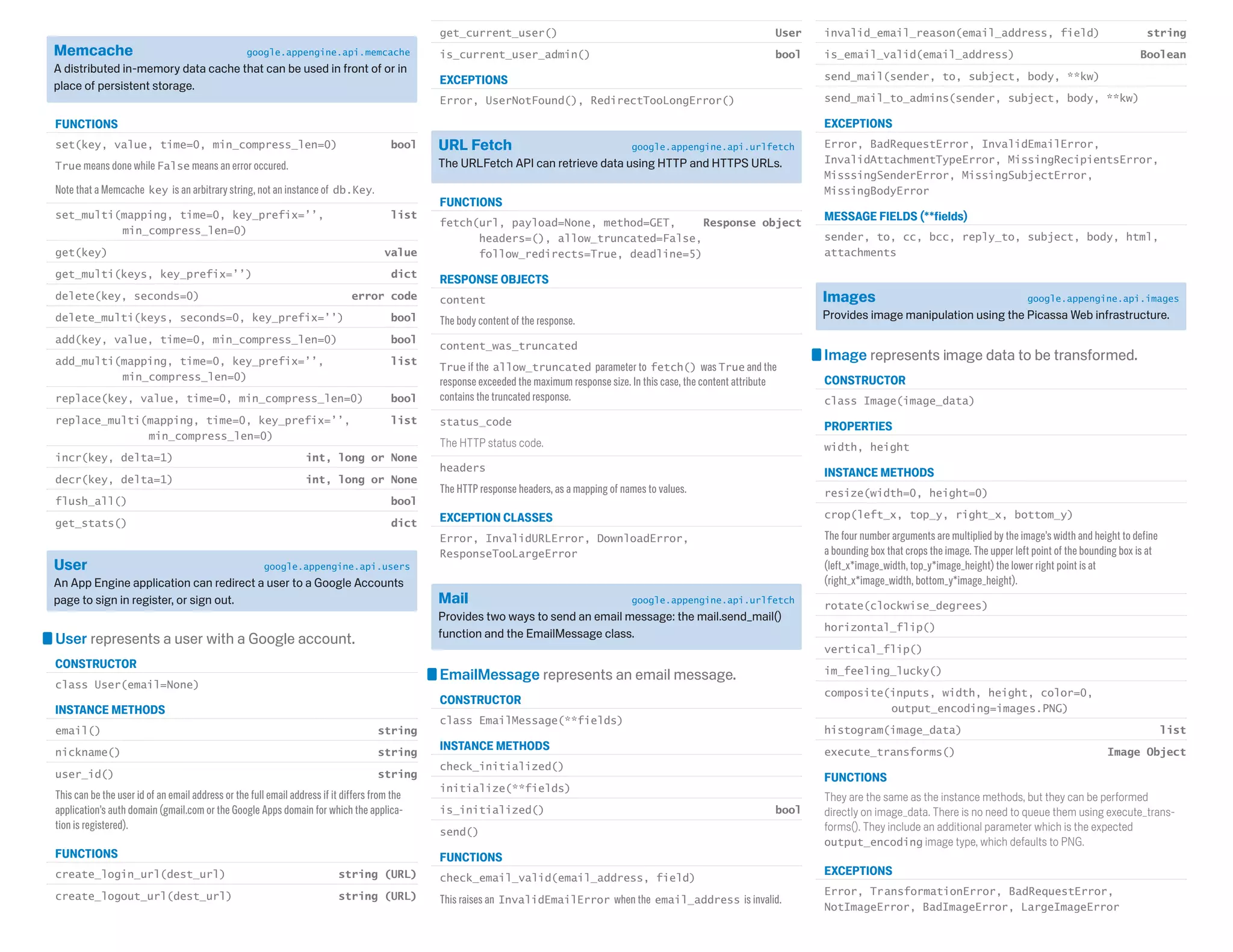This document summarizes Google App Engine's datastore and data modeling features. The datastore provides scalable storage and querying. It uses models defined by subclasses of Model. Properties on models define data types and are instances of the Property class. Queries use the Query class to retrieve and filter models. Keys uniquely identify entities and are represented as instances of the Key class.
![Google App Engine Property is the superclass for data model definitions. Query uses objects and methods to prepare queries. Python SDK 1.2.2 REVISION 1.1 05.21.09 CONSTRUCTOR CONSTRUCTOR class Property(verbose_name=None, name=None, Datastore google.appengine.ext.db class Query(model_class) indexed=True, default=None, choices=None A scalable storage and query engine. required=False, validator=None) INSTANCE METHODS filter(property_operator, value) self PACKAGE FUNCTIONS CLASS ATTRIBUTES order(property) self get(key) Model instance data_type ancestor(model_instance|key) self You can also pass multiple keys and it will return multiple Model instances. INSTANCE METHODS get() model instance or None put(model_instance) Key object default_value() value fetch(limit, offset=0) list of model instances You can also pass multiple model instances and it will return multiple keys. validate(value) value or exception count(limit=None) integer delete(model_instance|key) empty(value) bool run_in_transaction(function, *args, **kwargs) TYPE AND PROPERTY CLASSES Key represents a unique key for a datastore entity. run_in_transaction_custom_retries(retries, function, Property Class Value Type Sort Order CONSTRUCTOR *args, **kwargs) StringProperty str Unicode (str is treated as ASCII) class Key(encoded=None) unicode Model is the superclass for data model definitions. CLASS METHODS ByteStringProperty db.ByteString byte order CONSTRUCTOR Key.from_path(*args, **kwds) BooleanProperty bool False True This example creates a key for an Address entity with the numeric ID 9876 whose par- class Model(parent=None, key_name=None, **kwds) ent is a User entity with the named key ‘Boris’: IntegerProperty int Numeric CLASS METHODS long k = Key.from_path(‘User’, ‘Boris’, ‘Address’, 9876) get(key) Key object FloatProperty float Numeric INSTANCE METHODS get_by_id(id, parent=None) Model instance DateTimeProperty datetime.datetime Chronological app() Application name (string) You can also pass multiple ids and it will return multiple Model instances. DateProperty kind() Kind (string) get_by_key_name(key_name, parent=None) see above TimeProperty ListProperty list If ascending, by least element; if id() Numeric ID (int) You can also pass multiple ids and it will return multiple Model instances. StringListProperty descending, by greatest element name() Entity name (string) get_or_insert(key_name, **kwds) see above ReferenceProperty db.Key By path elements (kind, ID or name) id_or_name() Numeric ID(int) or name (string) SelfReferenceProperty all() Query object has_id_or_name() bool UserProperty user.User By email address gql(query_string, *args, **kwds) GQLQuery object parent() Key Examples: BlobProperty db.Blob (not orderable) s = Story.gql(“WHERE title = :1”, “The Little Prince”) TextProperty db.Text (not orderable) GQL is a SQL-like language for retrieving entities. s = Story.gql(“WHERE title = :title”, title=”The Little Prince”) SYNTAX CategoryProperty db.Category Unicode WHERE condition [AND condition ...] kind() Kind LinkProperty db.Link Unicode ORDER BY property [ASC | DESC] [,property [ASC | DESC]…] properties() dict LIMIT [offset,]count EmailProperty db.Email Unicode INSTANCE METHODS OFFSET offset key() Key GeoPtProperty db.GeoPt By latitude, then longitude condition := property { | = | | = | = | != } value put() Key IMProperty db.IM Unicode condition := property IN list delete() condition := ANCESTOR IS entity or key PhoneNumberProperty db.PhoneNumber Unicode list := (value, …) is_saved() bool PostalAddressProperty db.PostalAddress Unicode Note that :NUMBER and :NAME are substitutions for positional and keyword argu- parent() Model ments, referrring to *args (starting at 1) and **kwds respectively. See RatingProperty db.Rating Unicode parent_key() Key Model.gql() for example usage. Key-only queries are supported using either to_xml() XML SELECT __key__.](https://image.slidesharecdn.com/googleappenginecheatsheetpython12211-130212234341-phpapp01/75/Google-app-engine-cheat-sheet-1-2048.jpg)
